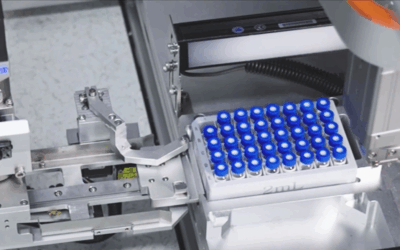Update June 2025
Oligonucleotide drugs (ONs) are synthetic molecules ranging from 12 to 30 nucleotides in length and typically made up of single or double strands of nucleotides. Through Watson-Crick base pairing, these drugs use target messenger RNA (mRNA), which results in the inhibition of gene expression and the prevention of erroneous protein production.
This unique mechanism allows ONs to regulate the transcription and translation of disease-related genes, including:
- Antisense oligonucleotides (ASOs)
- Small interfering RNA (siRNA)
- MicroRNA (miRNA)
Other ONs, like nucleic acid aptamers and decoy oligonucleotides, can bind directly to proteins, exerting their effects through non-hybridization mechanisms.
Understanding Oligonucleotide Mechanisms & Applications
The concept of using synthetic ONs for targeted gene regulation was first introduced in 1978 by Paul Zamecnik and Mary Stephenson. Despite issues with poor pharmacokinetics, low stability, susceptibility to nuclease degradation, and challenges in bioanalytical method development, technological advancements have addressed many of these concerns.
The stability of ONs has been enhanced, and the in vivo toxicity has been reduced thanks to modifications such as phosphorothioate linkages and locked nucleic acids. Moreover, improved delivery systems have enabled targeted organ delivery, e.g., to the liver, and have increased the efficiency of cellular uptake.
As of June 2025, the FDA has approved 21 RNA oligonucleotide therapeutics, including eight small interfering RNAs and 13 antisense oligonucleotides, with more than a hundred additional candidates in various stages of research. The specificity, shorter development cycles, and diverse target options of ONs offer substantial market potential, particularly for ASOs and siRNA.
Assessing the Toxicity Profile of Preclinical Oligonucleotide Drugs
ONs exhibit properties of both small molecules and biologics, and their toxicity can be classified into three main categories:
- On-target toxicity: adverse effects resulting from enhanced pharmacological activity related to the drug’s target.
- Hybridization-dependent off-target toxicity: off-target effects due to unintended hybridization with sequences like the intended target.
- Hybridization-independent off-target toxicity: toxicity arising from the physical or chemical properties of the oligonucleotide itself.
Common side effects include injection site reactions, immune-related effects, and gastrointestinal symptoms such as nausea and vomiting. The most significant safety concerns are hepatotoxicity, nephrotoxicity, and allergic reactions.
Building a Preclinical Safety Evaluation Plan
The safety evaluation of ONs often refers to guidelines designed for biotechnology-derived pharmaceuticals, such as ICH S6. Non-clinical safety evaluations typically involve one or two pharmacologically relevant animal species.
If no appropriate species are available, scientists can use alternative models for toxicity studies. Safety pharmacology assessments, including cardiovascular, respiratory, and central nervous system evaluations, are essential in repeated-dose toxicity studies.
Further, ONs have a longer half-life, so extending the evaluation period to assess delayed toxicity and recovery is usually necessary.
Overcoming Bioanalytical Challenges in ONs & Metabolites
Oligonucleotide drugs present unique bioanalytical challenges due to their structural and pharmacokinetic properties. Analytical methods must be carefully selected based on the type, size, sensitivity, and specificity requirements of the ONs.
Safety evaluations typically do not focus on degraded products of natural nuclease activity, but chemically modified ONs are assessed similarly to small molecule drugs.
Platforms such as LC-MS/MS, LC-FLD, hybrid-ELISA, and qPCR regularly meet diverse detection needs. LC-MS/MS, for instance, is widely used for its ability to detect antisense strands, sense strands, and metabolites, although it requires complex sample preparation processes. qPCR is often employed for higher sensitivity, offering sensitivity to the picogram or femtogram level.
Managing Immune-Related Toxicity Risks
For ONs to exert their effects, they must enter cells, a process that can activate the immune system. This activation may lead to B-cell proliferation and activation of macrophages, monocytes, NK cells, and dendritic cells. The immune response may include the secretion of chemokines and cytokines, as well as the activation of complement pathways. Given these risks, immunotoxicity evaluation should adhere to guidelines like ICH S8.
Immunogenicity Evaluation in Oligonucleotide Development
Unexpected immunogenic reactions can arise from the oligonucleotide sequences or new epitopes generated by the drug. US regulatory authorities emphasize the importance of immunogenicity evaluation in ON development.
Delayed onset of anti-drug antibodies (ADAs) is a known issue, and extending the sampling period for ADA analysis is recommended. A multi-tiered immunogenicity assessment is often necessary, particularly for ONs that produce modified proteins. The immunogenicity assessment strategy can refer to US regulatory authority guidelines for therapeutic protein products.
Conclusion
Oligonucleotide drugs represent a rapidly evolving class of therapeutics with unique development challenges, particularly in safety evaluation, bioanalysis, and immunogenicity. Despite these challenges, the continued advancement in technologies and methodologies holds great promise for the future of ONs in treating a wide array of diseases, particularly within the American pharmaceutical industry.
Stability testing for biopharmaceutical products is multifaceted, involving the meticulous evaluation of extractables and leachables, adherence to CGMP, and comprehensive final packaging testing. The complexity of biologics and extensive data management underscores the need for robust testing frameworks.
Staying committed to stringent, continuous testing and engaging experienced lab testing partners helps deliver accurate and timely stability testing data, ensuring patient safety and product efficacy.
As a global company with operations across Asia, Europe, and North America, WuXi AppTec provides a broad portfolio of R&D and manufacturing services that enable the global pharmaceutical and life sciences industry to advance discoveries and deliver groundbreaking treatments to patients. Through its unique business models, WuXi AppTec’s integrated, end-to-end services include chemistry drug CRDMO (Contract Research, Development and Manufacturing Organization), biology discovery, preclinical testing and clinical research services, helping customers improve the productivity of advancing healthcare products through cost-effective and efficient solutions. WuXi AppTec received an AA ESG rating from MSCI for the fourth consecutive year in 2024 and its open-access platform is enabling around 6,000 customers from over 30 countries to improve the health of those in need – and to realize the vision that “every drug can be made and every disease can be treated.”


